American Bonsai at the NC Arboretum
+95
kingsnake
Tom
MKBonsai
BrianS
manumidam
Chris Cochrane
Intricate Simplicity
chench53
KyleT
Maros Belan
DjTommy
Bolero
Gonetopot
Rick36
M. Frary
Van
Toshiro
fiona
Precarious
drbuzzbee
geo
LanceMac10
MichaelS
kimo
Chellis
Leo Schordje
FrankP999
dick benbow
BrianG
crust
TN Jim
Seth Ellwood
Wander
peterkang
Judgie
Kevin S - Wisco Bonsai
Vance Wood
JMcCoy
brett2013
GerhardGerber
lordy
Eric Group
my nellie
steveb
Jaybird
Todd Ellis
jgeanangel
Daygan
AlainK
Richard S
Randy_Davis
Robert J. Baran
David Brunner
William N. Valavanis
Jkd2572
Dale Cochoy
Jesse McMahon
prestontolbert
yamasuri
bingregory
Stephen Krall
DougB
Ashiod
JADunnagan
sayotefries
JudyB
Dan W.
Khaimraj Seepersad
DuncanJH
Dave Murphy
monte
MikeG
augustine
Russell Coker
Kev Bailey
lennard
BigDave
Marty Weiser
Smithy
coh
tmmason10
dorothy7774
gman
Dave Leppo
hometeamrocker
bwaynef
Billy M. Rhodes
Walter Pall
Sam Ogranaja
JimLewis
MartinSweeney
bonsaisr
Auballagh
John Quinn
Arthur Joura
99 posters
Page 3 of 40
Page 3 of 40 •  1, 2, 3, 4 ... 21 ... 40
1, 2, 3, 4 ... 21 ... 40 
 Re: American Bonsai at the NC Arboretum
Re: American Bonsai at the NC Arboretum
I'm very grateful that you can find time to post here Arthur and enjoy them immensely. Also sympathetic for the many in the US who are suffering drought and fire. I hope it rains for you soon.

Kev Bailey- Admin
 Re: American Bonsai at the NC Arboretum
Re: American Bonsai at the NC Arboretum
Once again, thanks, Arthur. That white pine is one of my new favorites. It is a very unusual species for bonsai, and I've use a picture of that tree to encourage people to try working with it.
On drought, heat. and fire, 19 firefighters died in Arizona last weekend when a blaze reversed course and flared over them. That happened just a few miles from where I used to visit my mother. Everything is so dry there, and 115+ degree temperatures aren't helping.
On drought, heat. and fire, 19 firefighters died in Arizona last weekend when a blaze reversed course and flared over them. That happened just a few miles from where I used to visit my mother. Everything is so dry there, and 115+ degree temperatures aren't helping.

JimLewis- Member
 Re: American Bonsai at the NC Arboretum
Re: American Bonsai at the NC Arboretum
Really enjoy your posts Arthur. I absolutely love that Chase Grove.
Mike
Mike
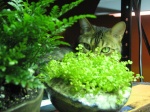
MikeG- Member
 Re: American Bonsai at the NC Arboretum
Re: American Bonsai at the NC Arboretum
Knowing just how busy you are makes reading your posts that much more enjoyable. Chase Rosade's Grove is AMAZING!!!! The azaleas add lots of character and depth to the planting as well as a perfect splash of color.
Thanks for keeping up with your posts here!!!
I hope you'll continue to do so.
Have a great 4th everyone!!!
Sam
PS - On pins and needles for the Expo this year. Can't wait.
Thanks for keeping up with your posts here!!!
I hope you'll continue to do so.
Have a great 4th everyone!!!
Sam
PS - On pins and needles for the Expo this year. Can't wait.

Sam Ogranaja- Member
 Re: American Bonsai at the NC Arboretum
Re: American Bonsai at the NC Arboretum
Arthur, I really like your posts and would love to visit the gardens someday. I have a question for you re: a quote I copied from one of your posts a while back.
"And finally, because we go to great lengths to avoid using pesticides in the Bonsai Exhibition Garden, it is a place teeming with all sorts of life. The 3 pictures that follow I think of as "the birds & the bees (& the skinks)".
If you have a few minutes someday to share some of the measures you use I would be very interested to hear about them. I am not a fan of the squish every bug you see then spray poison on it approach to bonsai cultivation.
Thanks, keep up the good work
Monte
"And finally, because we go to great lengths to avoid using pesticides in the Bonsai Exhibition Garden, it is a place teeming with all sorts of life. The 3 pictures that follow I think of as "the birds & the bees (& the skinks)".
If you have a few minutes someday to share some of the measures you use I would be very interested to hear about them. I am not a fan of the squish every bug you see then spray poison on it approach to bonsai cultivation.
Thanks, keep up the good work
Monte
monte- Member
 "The Chase Grove" tray landscape
"The Chase Grove" tray landscape
Kev, Jim and Sam - Thank you for your comments and continuing support! I would like to post more and hopefully when things slow down a bit (about late October) I will.
Mike - Thanks for reading and commenting. If we ever did a poll of the public's choice for the favorite piece in the NC Arboretum's bonsai collection, "The Chase Grove" would probably win. Everyone seems to like it and relate to it in some way.
As I mentioned, it was made by Chase Rosade in a demonstration at a convention back in the mid-90's, and it was purchased at auction that same weekend by a man from Rock Hill, South Carolina. That man did not have a way to get the large planting home with him at the end of the convention, so he asked Chase to bring it back to his nursery in Pennsylvania and hold it until arrangements could be made to transport it to SC. For whatever reason, those arrangements were never made. After more than a year of waiting, Chase called the man to tell him he could not hold the piece forever, and the man from Rock Hill then decided the planting was too large for him anyway and offered it to the Arboretum. As it happened, Chase was about to make a trip out to Mississippi, to Brussel's Nursery, and offered to haul the planting part of the way south to a prearranged meeting place and pass it off to me. That's how it came to be that one gray afternoon I drove out to the I-40 welcome center in East Tennessee, met up with Chase and his traveling partner, Jim Doyle, and transferred the more than 5' long planting from their van to mine. I did not really know Jim at that point and Chase was annoyed because I was late and kept them waiting there awhile, so we did not stick around to talk much. It took just a few minutes and then we drove off in our separate directions. It was kind of like an illicit contraband deal, only without the risk of going to prison.
Anyway, as soon as I got back to the Arboretum I made a photograph of the piece:
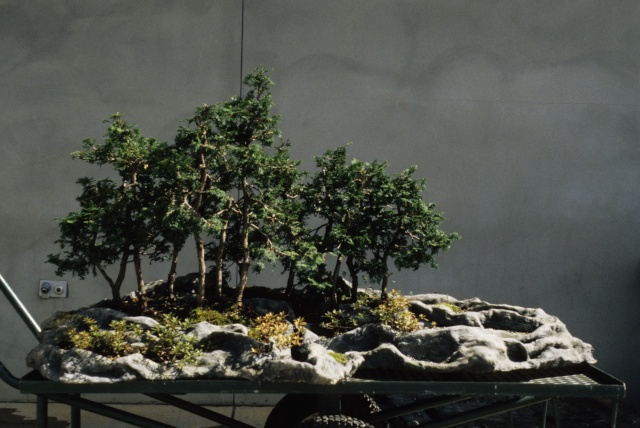
I think a big part of the appeal of this piece is in the gargantuan fabricated slab. Chase Rosade made that, too, using a technique not unlike that employed by people who make mountain scenery for a model railroad layout. He started with a wooden armature, which was then covered with hardware cloth (metal screening), which was then manipulated to form the contours and undulations of the "rock". Over that went strips of fiberglass cloth, like that used in auto body repair, which was first soaked in a slurry of Ciment Fondu. Lastly, the exterior was covered with a thin coat of Ciment Fondu applied with a paint brush. So, the slab is hollow and fortunately a lot lighter than it appears to be. I think Chase has made many such planters over the years, but this might have been one of his first on such a large scale. It is a neat idea, although the surface is a bit fragile, requiring minor repairs over time.
12 years went by before I needed to repot the planting. In this picture, made in June of 2009, you can see that all the plants have grown and filled out considerably:

It was necessary to take out plant material, both azalea and falsecypress, to alleviate overcrowding. This meant some alteration of the original design, but I tried to put it back together in a way that respected the feel of Chase's work. Here is how it looked in autumn of 2010, one growing season after the replanting occurred:

The plants responded favorably to being repotted. Here is a photograph from autumn of 2011, one year after the picture above was made, wherein you can see how the process of the landscape filling out is once more underway:

Finally, for the sake of easy comparison, here is the image of "The Chase Grove" that appeared in my previous post, showing it as it appeared in flower a few weeks ago:
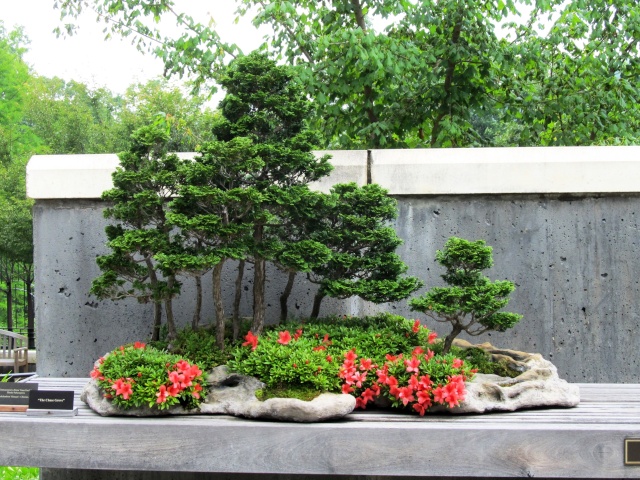
I named this planting in Chase's honor because he is one of the more important and influential figures in American bonsai, and we are proud to have a piece of his work in our collection. He is a genuinely likable guy, too.
Monte - I did not overlook your comment. I appreciate your interest in the pest management practices we employ at the Arboretum and intend to respond to your question. However, I am out of time right now. My next post will be on that subject. Thank you for reading!
Mike - Thanks for reading and commenting. If we ever did a poll of the public's choice for the favorite piece in the NC Arboretum's bonsai collection, "The Chase Grove" would probably win. Everyone seems to like it and relate to it in some way.
As I mentioned, it was made by Chase Rosade in a demonstration at a convention back in the mid-90's, and it was purchased at auction that same weekend by a man from Rock Hill, South Carolina. That man did not have a way to get the large planting home with him at the end of the convention, so he asked Chase to bring it back to his nursery in Pennsylvania and hold it until arrangements could be made to transport it to SC. For whatever reason, those arrangements were never made. After more than a year of waiting, Chase called the man to tell him he could not hold the piece forever, and the man from Rock Hill then decided the planting was too large for him anyway and offered it to the Arboretum. As it happened, Chase was about to make a trip out to Mississippi, to Brussel's Nursery, and offered to haul the planting part of the way south to a prearranged meeting place and pass it off to me. That's how it came to be that one gray afternoon I drove out to the I-40 welcome center in East Tennessee, met up with Chase and his traveling partner, Jim Doyle, and transferred the more than 5' long planting from their van to mine. I did not really know Jim at that point and Chase was annoyed because I was late and kept them waiting there awhile, so we did not stick around to talk much. It took just a few minutes and then we drove off in our separate directions. It was kind of like an illicit contraband deal, only without the risk of going to prison.
Anyway, as soon as I got back to the Arboretum I made a photograph of the piece:

I think a big part of the appeal of this piece is in the gargantuan fabricated slab. Chase Rosade made that, too, using a technique not unlike that employed by people who make mountain scenery for a model railroad layout. He started with a wooden armature, which was then covered with hardware cloth (metal screening), which was then manipulated to form the contours and undulations of the "rock". Over that went strips of fiberglass cloth, like that used in auto body repair, which was first soaked in a slurry of Ciment Fondu. Lastly, the exterior was covered with a thin coat of Ciment Fondu applied with a paint brush. So, the slab is hollow and fortunately a lot lighter than it appears to be. I think Chase has made many such planters over the years, but this might have been one of his first on such a large scale. It is a neat idea, although the surface is a bit fragile, requiring minor repairs over time.
12 years went by before I needed to repot the planting. In this picture, made in June of 2009, you can see that all the plants have grown and filled out considerably:

It was necessary to take out plant material, both azalea and falsecypress, to alleviate overcrowding. This meant some alteration of the original design, but I tried to put it back together in a way that respected the feel of Chase's work. Here is how it looked in autumn of 2010, one growing season after the replanting occurred:

The plants responded favorably to being repotted. Here is a photograph from autumn of 2011, one year after the picture above was made, wherein you can see how the process of the landscape filling out is once more underway:

Finally, for the sake of easy comparison, here is the image of "The Chase Grove" that appeared in my previous post, showing it as it appeared in flower a few weeks ago:

I named this planting in Chase's honor because he is one of the more important and influential figures in American bonsai, and we are proud to have a piece of his work in our collection. He is a genuinely likable guy, too.
Monte - I did not overlook your comment. I appreciate your interest in the pest management practices we employ at the Arboretum and intend to respond to your question. However, I am out of time right now. My next post will be on that subject. Thank you for reading!
Last edited by Arthur Joura on Fri Aug 02, 2013 6:48 am; edited 1 time in total

Arthur Joura- Member
 Re: American Bonsai at the NC Arboretum
Re: American Bonsai at the NC Arboretum
Thanks Arthur, looking forward to it, whenever you have some time of course. I enjoyed the story of the grove too, thanks.
Monte
Monte
monte- Member
 Integrated Pest Management (part 1)
Integrated Pest Management (part 1)
Try this: Find an insect or bug, something large would be best, perhaps one of these:
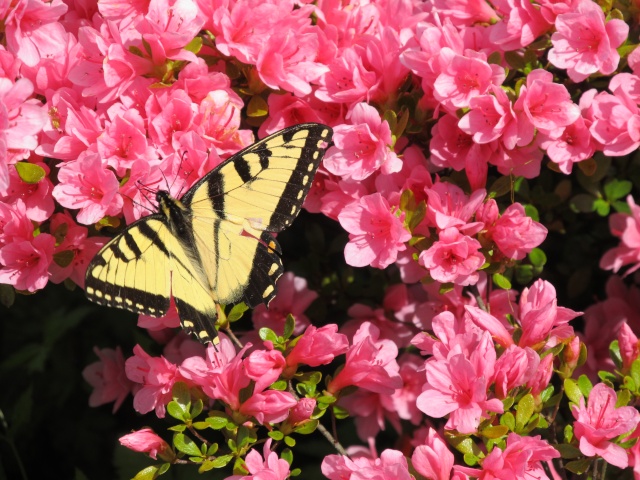
Now, tear off its wings. Take off its legs and antennae, too. Now lay it out in the sun on a hot sidewalk and watch it. It squirms and its mouth parts move. The creature is in agony. It probably will not make any noise, or at least none that our ears can hear, but if it could it would be screaming.
Of course you would not do such a cruel, barbaric thing and neither would I, but I do spray insecticides. You probably use them too, to protect yourself, or your pets, or your house, or your plants. Insecticides kill insects and bugs, usually by attacking their nervous system although sometimes they kill by suffocation or dessication, or inducing paralysis, or inhibiting energy production, or causing the creature to stop eating and so starve to death. The end result is death, though, and the route there is usually slow and torturous. How is it better to kill with insecticides as opposed to physically torturing an insect to death? If you are like me, you justify your use of these chemicals by describing the creatures you kill as being "bad bugs". Most people would include the following as "bad bugs": Fleas, ticks, mosquitoes, flies and cockroaches. People who enjoy growing plants will probably expand the list to include aphids, whitefly, thrips, spider mites and mealybugs. How about caterpillars? They eat leaves and can do a lot of damage to crops and ornamental plants, so they must be "bad bugs". But some of them turn into butterflies... And how about spiders? Most people seem to think of spiders as bad and will kill them, largely out of fear, but spiders eat other insects and so might be thought of as "good bugs".
It gets complicated, because it is complicated. Life is an unimaginably huge and complex system, in which all the parts are somehow interwoven. So much is still unknown to us. A great deal of brilliant science has gone into the formulation of modern insecticides and still they are blunt instruments, especially in the way they are so often misused. When I started out in horticulture I was shocked to learn how drenched the whole business is in pesticides, and how accepted their use is. I was repelled by this, and yet over time I came to be more accepting of it, and now looking back I realize that I have killed literally millions of living creatures, and did so with intent. I cannot make excuses for this behavior. I made a rational choice: I grow plants for a living, so I have to protect the plants I grow. Insects that eat plants are my enemy, so I destroy them.
Still, I think of myself as one who loves nature, and so this wanton destruction of certain parts of it I deem undesirable does not sit comfortably with me. I still do it - I sprayed fungicide on Tuesday, horticultural oil on Thursday and herbicide today - but I work to remain conscious of what I am doing and to do it as responsibly as I can. I have made the choice to kill certain things, but I try to be both intelligent and sensitive in the way I go about it. This is a horribly compromised position to be in, but when I look around me it seems that being horribly compromised is part of the human condition.
In my work at the Arboretum, I strive to practice what is referred to as Integrated Pest Management. Here is a definition from the web site of the US Environmental Protection Agency http://www.epa.gov/opp00001/factsheets/ipm.htm:
"Integrated Pest Management (IPM) is an effective and environmentally sensitive approach to pest management that relies on a combination of common-sense practices. IPM programs use current, comprehensive information on the life cycles of pests and their interaction with the environment. This information, in combination with available pest control methods, is used to manage pest damage by the most economical means, and with the least possible hazard to people, property, and the environment.
The IPM approach can be applied to both agricultural and non-agricultural settings, such as the home, garden, and workplace. IPM takes advantage of all appropriate pest management options including, but not limited to, the judicious use of pesticides. In contrast, organic food production applies many of the same concepts as IPM but limits the use of pesticides to those that are produced from natural sources, as opposed to synthetic chemicals."
A big part of my personal approach is to begin by thinking of the Bonsai Exhibition Garden, and the bonsai displayed within it, as being a tiny piece of the natural world. The walls that contain the garden do not exclude it from greater nature, just as the pot that holds the bonsai does not exclude that plant from greater nature. I have to be careful what I do with the garden and with the bonsai because they are connected to everything else in nature.
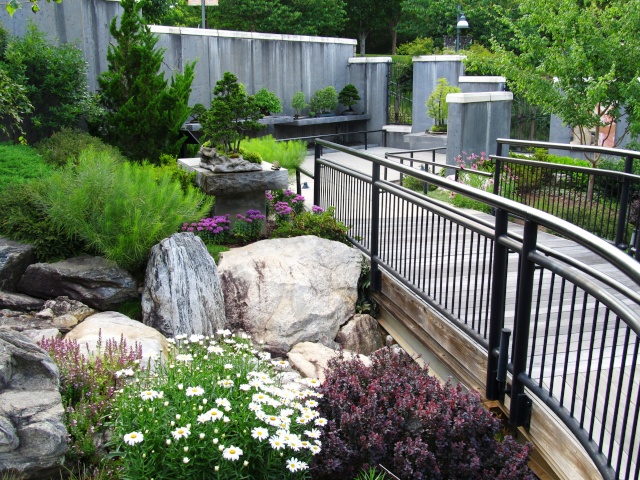

Now, tear off its wings. Take off its legs and antennae, too. Now lay it out in the sun on a hot sidewalk and watch it. It squirms and its mouth parts move. The creature is in agony. It probably will not make any noise, or at least none that our ears can hear, but if it could it would be screaming.
Of course you would not do such a cruel, barbaric thing and neither would I, but I do spray insecticides. You probably use them too, to protect yourself, or your pets, or your house, or your plants. Insecticides kill insects and bugs, usually by attacking their nervous system although sometimes they kill by suffocation or dessication, or inducing paralysis, or inhibiting energy production, or causing the creature to stop eating and so starve to death. The end result is death, though, and the route there is usually slow and torturous. How is it better to kill with insecticides as opposed to physically torturing an insect to death? If you are like me, you justify your use of these chemicals by describing the creatures you kill as being "bad bugs". Most people would include the following as "bad bugs": Fleas, ticks, mosquitoes, flies and cockroaches. People who enjoy growing plants will probably expand the list to include aphids, whitefly, thrips, spider mites and mealybugs. How about caterpillars? They eat leaves and can do a lot of damage to crops and ornamental plants, so they must be "bad bugs". But some of them turn into butterflies... And how about spiders? Most people seem to think of spiders as bad and will kill them, largely out of fear, but spiders eat other insects and so might be thought of as "good bugs".
It gets complicated, because it is complicated. Life is an unimaginably huge and complex system, in which all the parts are somehow interwoven. So much is still unknown to us. A great deal of brilliant science has gone into the formulation of modern insecticides and still they are blunt instruments, especially in the way they are so often misused. When I started out in horticulture I was shocked to learn how drenched the whole business is in pesticides, and how accepted their use is. I was repelled by this, and yet over time I came to be more accepting of it, and now looking back I realize that I have killed literally millions of living creatures, and did so with intent. I cannot make excuses for this behavior. I made a rational choice: I grow plants for a living, so I have to protect the plants I grow. Insects that eat plants are my enemy, so I destroy them.
Still, I think of myself as one who loves nature, and so this wanton destruction of certain parts of it I deem undesirable does not sit comfortably with me. I still do it - I sprayed fungicide on Tuesday, horticultural oil on Thursday and herbicide today - but I work to remain conscious of what I am doing and to do it as responsibly as I can. I have made the choice to kill certain things, but I try to be both intelligent and sensitive in the way I go about it. This is a horribly compromised position to be in, but when I look around me it seems that being horribly compromised is part of the human condition.
In my work at the Arboretum, I strive to practice what is referred to as Integrated Pest Management. Here is a definition from the web site of the US Environmental Protection Agency http://www.epa.gov/opp00001/factsheets/ipm.htm:
"Integrated Pest Management (IPM) is an effective and environmentally sensitive approach to pest management that relies on a combination of common-sense practices. IPM programs use current, comprehensive information on the life cycles of pests and their interaction with the environment. This information, in combination with available pest control methods, is used to manage pest damage by the most economical means, and with the least possible hazard to people, property, and the environment.
The IPM approach can be applied to both agricultural and non-agricultural settings, such as the home, garden, and workplace. IPM takes advantage of all appropriate pest management options including, but not limited to, the judicious use of pesticides. In contrast, organic food production applies many of the same concepts as IPM but limits the use of pesticides to those that are produced from natural sources, as opposed to synthetic chemicals."
A big part of my personal approach is to begin by thinking of the Bonsai Exhibition Garden, and the bonsai displayed within it, as being a tiny piece of the natural world. The walls that contain the garden do not exclude it from greater nature, just as the pot that holds the bonsai does not exclude that plant from greater nature. I have to be careful what I do with the garden and with the bonsai because they are connected to everything else in nature.


Arthur Joura- Member
 Integrated Pest Management (part 2)
Integrated Pest Management (part 2)
Starting from the point of consciousness that our bonsai and the gardens for which we are responsible are a part of, and not separate from, the rest of nature, the next step is to acquire as much knowledge as possible regarding the way that nature works. This is an ongoing, never ending effort, but not at all a dreary chore. Endlessly fascinating, the study of nature is also deeply humbling. With each little piece of the puzzle you think you put in place comes the greater realization that the puzzle is gigantic and multi dimensional, and possibly some parts of it you thought you had right do not actually go together the way you thought they did.
The greatest aid to learning about the environment around you is to be observant. I spend a great deal of time at work just looking - at the bonsai, at the plants in the garden. Part of this is related to design decisions, such as, should I remove that lowest branch? Should I replace those pink flowering azaleas with something other that has blooms more in harmony with the garden's overall color scheme? But another part of my looking has to do with appearances as they relate to the health of the plants. That plant looks a little droopy - why? The leaves on that plant are damaged - what did it? Here are 2 examples:


Both images show damaged foliage, but what caused the damage? Knowing the answer informs the response you might choose to make as a grower. The first picture is of damage done by the hungry mouths of Japanese Beetles. Spraying the damaged plant with a contact insecticide, like horticultural soap or something more toxic, such as Orthene, will not help unless the bugs are there at the time and are covered by the chemical. For all that, if the beetles are on the leaf you can simply hold a jar of soapy water under them, tap the leaf and they will fall in the solution and drown, which is about the least environmentally damaging way you can address the problem. Or, you can do it in the least environmentally sensitive way and sprinkle Sevin dust all over the plant, and then every bug that comes in contact with it - good or bad - will be subject to the toxic effects of the chemical (and as a note of interest, the active agent in Sevin, called Carbaryl, is listed as a likely carcinogen in humans.) What about the damage to the leaves shown in the second picture? That was done by hail. No pesticide application will help.
One thing I am always on the lookout for at this time of year are leaves that look like this:
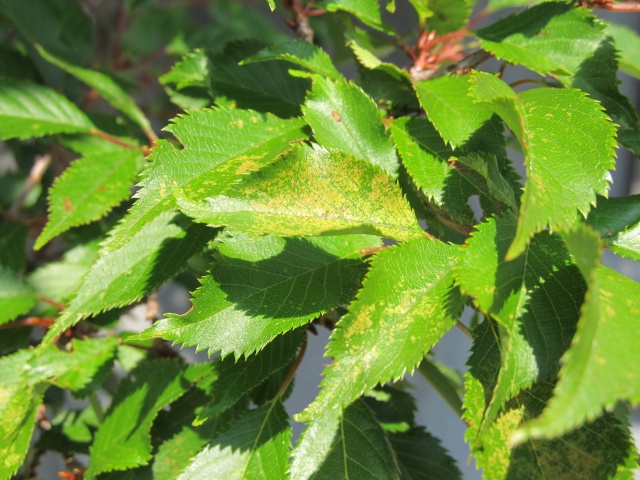
Flip over such leaves and you may find this:
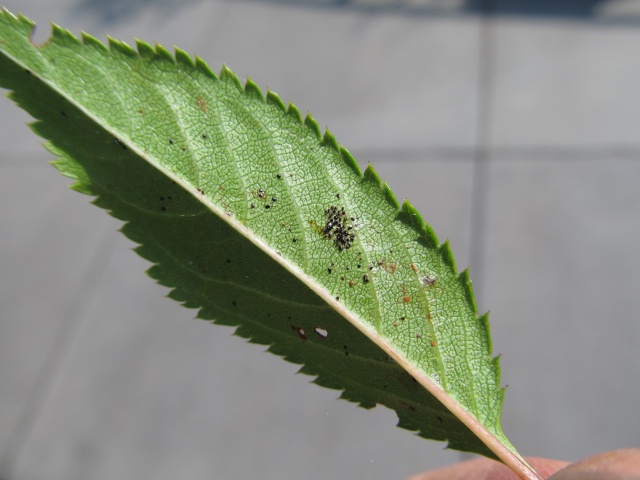
Are those little dark dots what is causing the damage on the top side of the leaf? No, those are the droppings of the creature that is damaging the leaves. Here is the culprit:
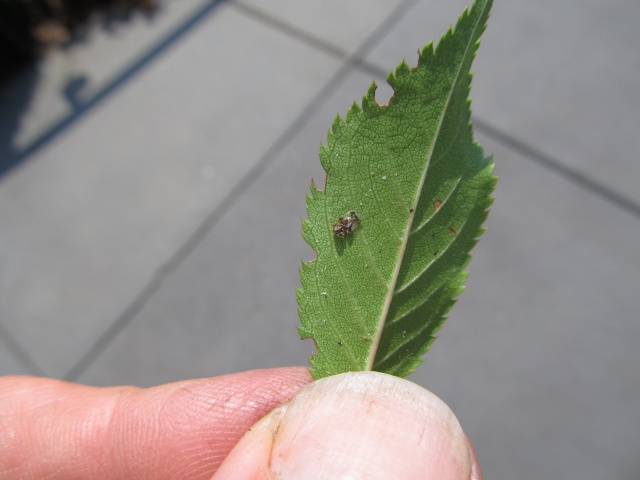
This is a Lace Bug, and the damage they do is by hiding on the underside of leaves and sucking plant juice out of them. They are amazing creatures to see under a microscope, very intricate and lace like in their appearance (hence the name). They are a persistent problem for my plants every summer:
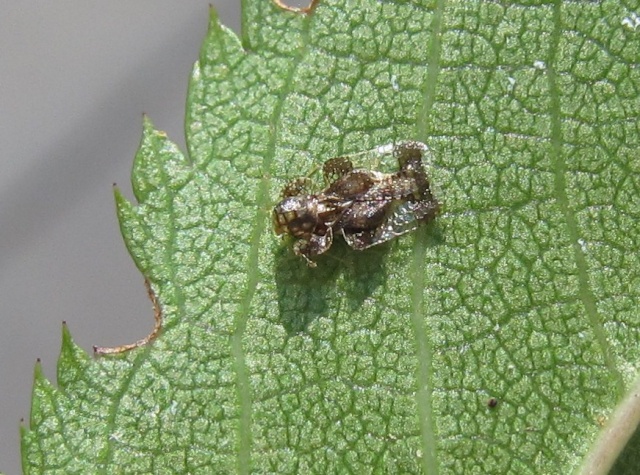
Lace bugs are easily treatable with low level insecticides like horticultural oil or horticultural soap. If I find them on a bonsai I will usually spray them. When Lace Bugs turn up on a larger plant in the garden I have a different method of control, which I will discuss a little later.
Here is another example of the benefits of closely observing your plants. I was walking past this Stewartia bonsai one day and something out of place caught my eye. I first thought a branch had been broken:

I moved in for a closer look:

No need for insecticide in this case, just simple physical removal. I did not kill this caterpillar, I think just because he looked so cool, but I did airlift him out of the garden moments after this picture was made:
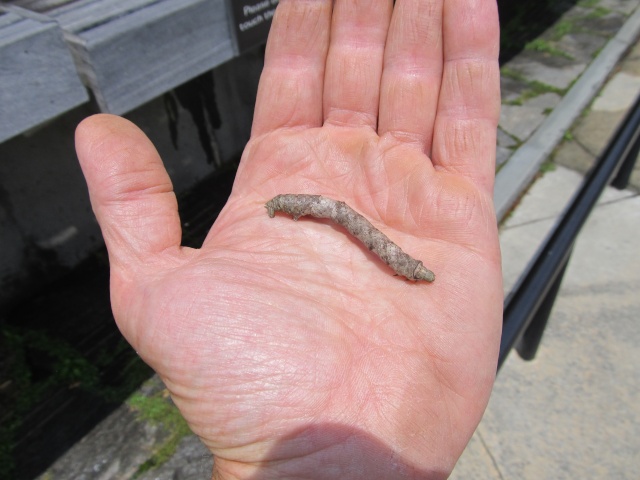
One truth quickly learned by being observant and studying the ways of nature is that the world is full of hungry things, and a great many of these things eat plants. As previously noted, those of us who grow plants tend to characterize those creatures that eat them as the bad guys, and in the same simplistic vernacular those creatures that eat the things that eat plants are the good guys. In Integrated Pest Management, one of the most effective tools in controlling the bad guys is promoting the presence of the good guys, also known as the beneficials. In the last 2 years I have released thousands of beneficial insects in the Bonsai Exhibition Garden, as well as in the hoop house where we grow the bonsai not on display in the garden. I purchase them mail order from a company called Biobest (http://www.biobest.be/home/3/), but there are other suppliers out there and a web search for beneficial insect suppliers will provide leads.
Although I have bought and released several different beneficial species, the one I have used the most looks like this:

Actually, they do not look like that when I release them. The picture shows an adult Lacewing, which feeds primarily on nectar. What I release are their larval form, sometimes called Aphid Lions, which are so tiny when I get them that they are difficult to see without a magnifying lens. They are voracious feeders who especially enjoy aphids but also eat a broad spectrum of other bugs and insects, including each other if there are not sufficient alternatives available. Lacewings are my weapon of choice to combat Lace Bugs when they turn up on landscape plants in the garden.
The hope when beneficials are released is that they will not only eat a great number of pests, but will also reproduce and establish a lasting presence. I know Lacewings are doing that in our garden because I have seen this evidence:

Look very closely at the leaf in the very center of the picture and you will see tiny white dots dangling from its underside. Those are Lacewing eggs, each suspended by a thread which separates them from each other, presumably so they do not devour their siblings upon arrival.
Several common garden insects are well known beneficials, such as the Praying Mantis:

And the Lady Beetle (these 2 here shown in the act of creating more beneficials - way to go girls!):
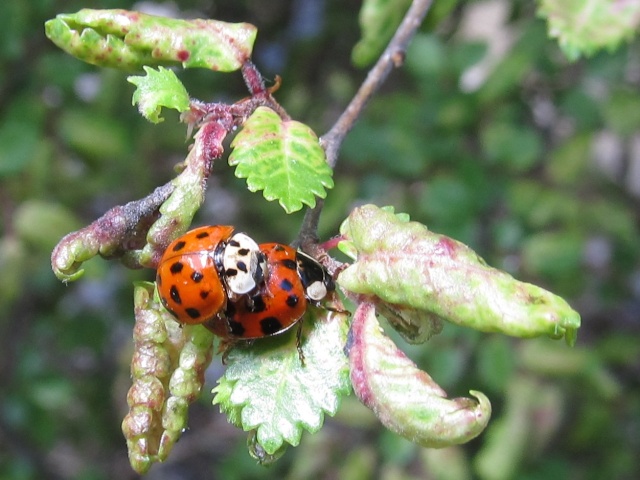
Most people know these are "good bugs" and will not harm them, but what if they happen to get sprayed by insecticides being put out for pest species? Then they die, and all the pests they might have eaten get to live. This is one reason why it is important to be careful when choosing to apply insecticides - you may inadvertently be undermining nature's own pest control. Look for the presence of beneficials before you resort to chemicals, and if you see them, consider giving them time to work. Of course, you have to know what you are looking for. There are so many different species of bugs and insects and they do not wear white hats and black hats so you can tell them apart. Take this one for example:
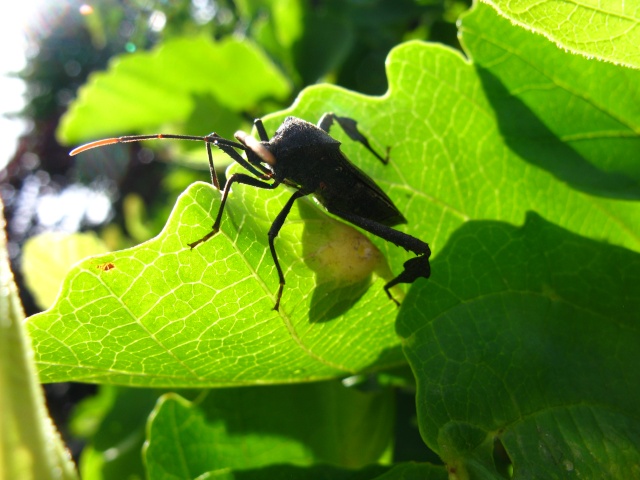
Good guy or bad guy? Looks kind of creepy, and has a creepy name too - Assassin Bug... but, it is a beneficial.
Of course there are a lot of beneficials that are not insects or bugs. The Bonsai Exhibition Garden has an impressive population of insect eating skinks and lizards, such as this Eastern Fence Lizard:
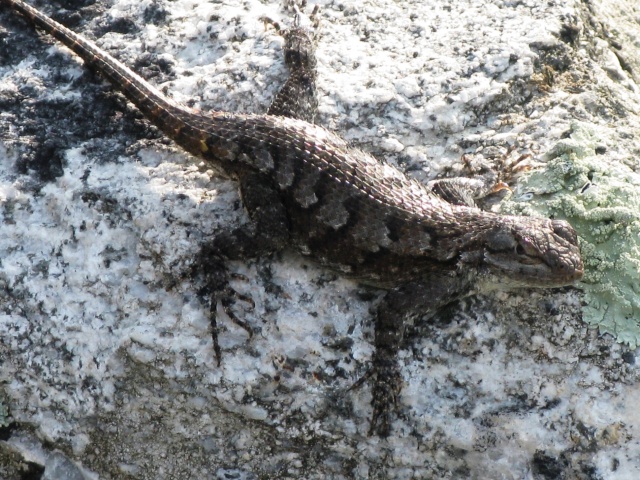
Reptiles, birds, small mammals - there are many creatures that live by eating insects. Their presence in your garden or in the vicinity of your bonsai can work to your benefit, so it makes sense to promote their well being. Part of what they need to survive is food, and their food in large part are the bugs and insects that eat your plants, and this means there needs to be some of them present, too. Wait a minute... in order to have a healthy presence of the beneficials there has to be a presence of the pests? This would seem to mean that it is in some way desirable to have about a certain population of the very things we do not want to have. This is all too confusing. Would it not be easier just to kill everything???
As I said before, it gets complicated.
The greatest aid to learning about the environment around you is to be observant. I spend a great deal of time at work just looking - at the bonsai, at the plants in the garden. Part of this is related to design decisions, such as, should I remove that lowest branch? Should I replace those pink flowering azaleas with something other that has blooms more in harmony with the garden's overall color scheme? But another part of my looking has to do with appearances as they relate to the health of the plants. That plant looks a little droopy - why? The leaves on that plant are damaged - what did it? Here are 2 examples:


Both images show damaged foliage, but what caused the damage? Knowing the answer informs the response you might choose to make as a grower. The first picture is of damage done by the hungry mouths of Japanese Beetles. Spraying the damaged plant with a contact insecticide, like horticultural soap or something more toxic, such as Orthene, will not help unless the bugs are there at the time and are covered by the chemical. For all that, if the beetles are on the leaf you can simply hold a jar of soapy water under them, tap the leaf and they will fall in the solution and drown, which is about the least environmentally damaging way you can address the problem. Or, you can do it in the least environmentally sensitive way and sprinkle Sevin dust all over the plant, and then every bug that comes in contact with it - good or bad - will be subject to the toxic effects of the chemical (and as a note of interest, the active agent in Sevin, called Carbaryl, is listed as a likely carcinogen in humans.) What about the damage to the leaves shown in the second picture? That was done by hail. No pesticide application will help.
One thing I am always on the lookout for at this time of year are leaves that look like this:

Flip over such leaves and you may find this:

Are those little dark dots what is causing the damage on the top side of the leaf? No, those are the droppings of the creature that is damaging the leaves. Here is the culprit:

This is a Lace Bug, and the damage they do is by hiding on the underside of leaves and sucking plant juice out of them. They are amazing creatures to see under a microscope, very intricate and lace like in their appearance (hence the name). They are a persistent problem for my plants every summer:

Lace bugs are easily treatable with low level insecticides like horticultural oil or horticultural soap. If I find them on a bonsai I will usually spray them. When Lace Bugs turn up on a larger plant in the garden I have a different method of control, which I will discuss a little later.
Here is another example of the benefits of closely observing your plants. I was walking past this Stewartia bonsai one day and something out of place caught my eye. I first thought a branch had been broken:

I moved in for a closer look:

No need for insecticide in this case, just simple physical removal. I did not kill this caterpillar, I think just because he looked so cool, but I did airlift him out of the garden moments after this picture was made:

One truth quickly learned by being observant and studying the ways of nature is that the world is full of hungry things, and a great many of these things eat plants. As previously noted, those of us who grow plants tend to characterize those creatures that eat them as the bad guys, and in the same simplistic vernacular those creatures that eat the things that eat plants are the good guys. In Integrated Pest Management, one of the most effective tools in controlling the bad guys is promoting the presence of the good guys, also known as the beneficials. In the last 2 years I have released thousands of beneficial insects in the Bonsai Exhibition Garden, as well as in the hoop house where we grow the bonsai not on display in the garden. I purchase them mail order from a company called Biobest (http://www.biobest.be/home/3/), but there are other suppliers out there and a web search for beneficial insect suppliers will provide leads.
Although I have bought and released several different beneficial species, the one I have used the most looks like this:

Actually, they do not look like that when I release them. The picture shows an adult Lacewing, which feeds primarily on nectar. What I release are their larval form, sometimes called Aphid Lions, which are so tiny when I get them that they are difficult to see without a magnifying lens. They are voracious feeders who especially enjoy aphids but also eat a broad spectrum of other bugs and insects, including each other if there are not sufficient alternatives available. Lacewings are my weapon of choice to combat Lace Bugs when they turn up on landscape plants in the garden.
The hope when beneficials are released is that they will not only eat a great number of pests, but will also reproduce and establish a lasting presence. I know Lacewings are doing that in our garden because I have seen this evidence:

Look very closely at the leaf in the very center of the picture and you will see tiny white dots dangling from its underside. Those are Lacewing eggs, each suspended by a thread which separates them from each other, presumably so they do not devour their siblings upon arrival.
Several common garden insects are well known beneficials, such as the Praying Mantis:

And the Lady Beetle (these 2 here shown in the act of creating more beneficials - way to go girls!):

Most people know these are "good bugs" and will not harm them, but what if they happen to get sprayed by insecticides being put out for pest species? Then they die, and all the pests they might have eaten get to live. This is one reason why it is important to be careful when choosing to apply insecticides - you may inadvertently be undermining nature's own pest control. Look for the presence of beneficials before you resort to chemicals, and if you see them, consider giving them time to work. Of course, you have to know what you are looking for. There are so many different species of bugs and insects and they do not wear white hats and black hats so you can tell them apart. Take this one for example:

Good guy or bad guy? Looks kind of creepy, and has a creepy name too - Assassin Bug... but, it is a beneficial.
Of course there are a lot of beneficials that are not insects or bugs. The Bonsai Exhibition Garden has an impressive population of insect eating skinks and lizards, such as this Eastern Fence Lizard:

Reptiles, birds, small mammals - there are many creatures that live by eating insects. Their presence in your garden or in the vicinity of your bonsai can work to your benefit, so it makes sense to promote their well being. Part of what they need to survive is food, and their food in large part are the bugs and insects that eat your plants, and this means there needs to be some of them present, too. Wait a minute... in order to have a healthy presence of the beneficials there has to be a presence of the pests? This would seem to mean that it is in some way desirable to have about a certain population of the very things we do not want to have. This is all too confusing. Would it not be easier just to kill everything???
As I said before, it gets complicated.

Arthur Joura- Member
 Re: American Bonsai at the NC Arboretum
Re: American Bonsai at the NC Arboretum
It is complicated, so thanks for helping it become a bit simpler.
If you look in our section that deals with sick or damaged plants -- -- it is obvious that many bonsaiests are convinced that the only good bug is a dead bug. We try to suggest remedies other than the nuclear option of spraying everything in sight. This will be a big help.
If you look in our section that deals with sick or damaged plants -- -- it is obvious that many bonsaiests are convinced that the only good bug is a dead bug. We try to suggest remedies other than the nuclear option of spraying everything in sight. This will be a big help.

JimLewis- Member
 Integrated Pest Management (part 3)
Integrated Pest Management (part 3)
The "kill them all" approach to pest control is misguided for 2 fundamental reasons: 1) it is not possible; and, 2) it is not actually desirable.
Plants are the ground floor of the food pyramid, and as such have the greatest number of things feeding on them. If a grower eradicates all the harmful bugs or insects on a given crop, be it bonsai or tomatoes or what have you, it is only a matter of time until another population of plant eaters turns up. So, the grower once again douses the crop with insecticide, the problem temporarily goes away, but then it returns and the sequence is repeated however many times over. Aside from the inconvenience and expense of constantly reapplying the insecticide, a person might well decide that this method was an acceptable way to go about the business of producing plants that did not show the signs of pest damage. You may not be able to kill them all, but you can kill them again, and again, and again, and again...
The problem here goes back to that whole pesky business of the web of life, and the fact that all living things on the planet are in some way connected. Your intention may be to do away with the aphids (or mealybugs, or spider mites, or whitefly) but in so doing you are also causing a certain amount of collateral damage in the population of other creatures, including those who, unmolested, might help keep the pest numbers at an acceptable level. What constitutes an acceptable level? If your idea is to produce perfection - that is, plants completely free of any cosmetic defects - then your acceptable level of pest presence is going to be ridiculously low; as in, the pests can be there only so long as they do no damage. Good luck with that! The question you might want to ask yourself is, where did you get the idea that plants are supposed to look perfect? In gardening catalogues and bonsai magazines the plants may look perfect, but this has much more to do with the art of photography than the reality of living plants in nature.
Another source of our illusionary ideas about perfect plants comes from the people who are ready to sell us the products necessary to achieve these desirable results. Since the end of World War II, when the munitions industries largely converted from the production of weapons to the production of synthetic chemical fertilizers and pesticides, a great revolution has occurred in the production of food. Bypassing the whole argument about whether this is an overall good or bad development, it is safe to say that the changes wrought by this revolution have spilled over into many areas of modern life and particularly those that have to do with growing all kinds of plants, including bonsai. The end result of this can be witnessed in our tendency, when faced with a plant that looks unhealthy, to first think "What can I spray on it?"
One of the greatest dangers inherent in the use of chemical pesticides is that they are relatively cheap and easily available to anyone, regardless of the competence, intelligence or sanity of the buyer. These are highly lethal substances that can be purchased by anyone at the nearest big box hardware store. The safety of these chemicals depends on the applicator using them the correct way, and especially at the correct rate. Overuse of pesticides is commonplace and one of the pitfalls of this is that the targeted pests can and do over time build up resistance to the chemicals. Then it takes more and more pesticide to achieve ever decreasing results. Meanwhile, presence of the chemicals builds in the environment and begins to affect non-target life forms, sometimes including humans.
The subject of petrochemicals used in plant production, and the subject of environmentalism, and the complexities of how these 2 concerns are completely intertwined, is, I suspect, outside the realm of interest for many people in the world of bonsai. This strikes me as strange, but I accept it as so. The whole bundle of issues is expansively complex, and I do not pretend to do anything here other than lightly scratch the surface with a few observations and questions for your consideration. Those who have real interest in Integrated Pest Management or organic plant production will find all the information they might desire somewhere on the Internet, although the usual cautions about believing everything you read are certainly applicable.
I make no claim to being an expert in this area. I do, however, have an active interest in both plant production and environmentalism and think these interests have strong relevance to my work in bonsai and the ongoing development of the Arboretum's Bonsai Exhibition Garden. I am an active student of Integrated Pest Management and try to put into practice the things I have learned.
Here, then, is a rudimentary list of best practices as well as a few behaviors to avoid as regards pest management:
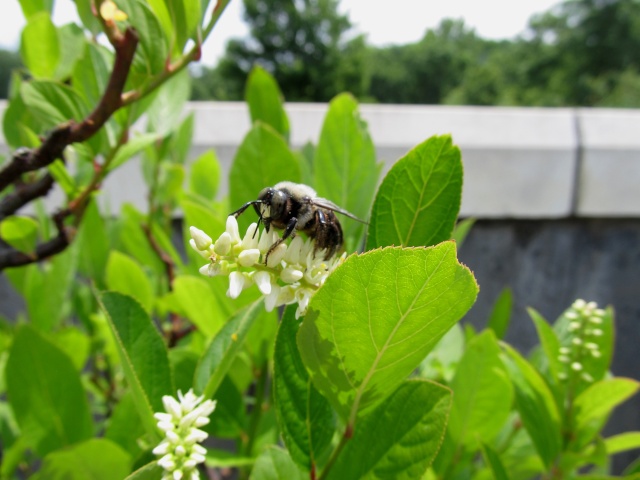
Plants are the ground floor of the food pyramid, and as such have the greatest number of things feeding on them. If a grower eradicates all the harmful bugs or insects on a given crop, be it bonsai or tomatoes or what have you, it is only a matter of time until another population of plant eaters turns up. So, the grower once again douses the crop with insecticide, the problem temporarily goes away, but then it returns and the sequence is repeated however many times over. Aside from the inconvenience and expense of constantly reapplying the insecticide, a person might well decide that this method was an acceptable way to go about the business of producing plants that did not show the signs of pest damage. You may not be able to kill them all, but you can kill them again, and again, and again, and again...
The problem here goes back to that whole pesky business of the web of life, and the fact that all living things on the planet are in some way connected. Your intention may be to do away with the aphids (or mealybugs, or spider mites, or whitefly) but in so doing you are also causing a certain amount of collateral damage in the population of other creatures, including those who, unmolested, might help keep the pest numbers at an acceptable level. What constitutes an acceptable level? If your idea is to produce perfection - that is, plants completely free of any cosmetic defects - then your acceptable level of pest presence is going to be ridiculously low; as in, the pests can be there only so long as they do no damage. Good luck with that! The question you might want to ask yourself is, where did you get the idea that plants are supposed to look perfect? In gardening catalogues and bonsai magazines the plants may look perfect, but this has much more to do with the art of photography than the reality of living plants in nature.
Another source of our illusionary ideas about perfect plants comes from the people who are ready to sell us the products necessary to achieve these desirable results. Since the end of World War II, when the munitions industries largely converted from the production of weapons to the production of synthetic chemical fertilizers and pesticides, a great revolution has occurred in the production of food. Bypassing the whole argument about whether this is an overall good or bad development, it is safe to say that the changes wrought by this revolution have spilled over into many areas of modern life and particularly those that have to do with growing all kinds of plants, including bonsai. The end result of this can be witnessed in our tendency, when faced with a plant that looks unhealthy, to first think "What can I spray on it?"
One of the greatest dangers inherent in the use of chemical pesticides is that they are relatively cheap and easily available to anyone, regardless of the competence, intelligence or sanity of the buyer. These are highly lethal substances that can be purchased by anyone at the nearest big box hardware store. The safety of these chemicals depends on the applicator using them the correct way, and especially at the correct rate. Overuse of pesticides is commonplace and one of the pitfalls of this is that the targeted pests can and do over time build up resistance to the chemicals. Then it takes more and more pesticide to achieve ever decreasing results. Meanwhile, presence of the chemicals builds in the environment and begins to affect non-target life forms, sometimes including humans.
The subject of petrochemicals used in plant production, and the subject of environmentalism, and the complexities of how these 2 concerns are completely intertwined, is, I suspect, outside the realm of interest for many people in the world of bonsai. This strikes me as strange, but I accept it as so. The whole bundle of issues is expansively complex, and I do not pretend to do anything here other than lightly scratch the surface with a few observations and questions for your consideration. Those who have real interest in Integrated Pest Management or organic plant production will find all the information they might desire somewhere on the Internet, although the usual cautions about believing everything you read are certainly applicable.
I make no claim to being an expert in this area. I do, however, have an active interest in both plant production and environmentalism and think these interests have strong relevance to my work in bonsai and the ongoing development of the Arboretum's Bonsai Exhibition Garden. I am an active student of Integrated Pest Management and try to put into practice the things I have learned.
Here, then, is a rudimentary list of best practices as well as a few behaviors to avoid as regards pest management:
- Always try to diagnose the problem before doing something about it. Knowing exactly what you are dealing with will help you make intelligent choices as to how the problem should be addressed.
- For that matter, wait until there is a problem before deploying a solution! The practice of putting out insecticides as a preventative or prophylactic measure sounds plausible, but often the real effect of this practice is to help pests build a tolerance to the chemical being used.
- Always use the least toxic response possible. Sometimes a strong spray of water from a hose is enough to dislodge damaging pests and wash them away. Horticultural oil and insecticidal soap are effective but relatively benign first options as far as pesticides are concerned, and are less likely to have a lasting effect on the environment.
- When using any pesticide, read the label beforehand. The label gives information about the proper use of the chemical, the pests on which it will have effect, the level of danger it poses to the environment and the user, and the personal safety equipment necessary for use. If you actually take time to read the label, you will notice that it includes language to warn you it is a crime to use the product in any way other than that specified. If reading this stuff gives you the willies, it should! But not reading the label keeps a person ignorant, and choosing to remain so makes a person stupid.
- Avoid using systemic insecticides. These chemicals have become very popular in recent years, including among bonsai growers, and why not? The latest in a long line of miracle solutions, all one need do is apply the chemical once and for a period of many months no insect will eat your plant without paying the ultimate price. Of course no pollinators will be able to drink nectar or bring back food for its offspring or the rest of the hive without paying the ultimate price, either. And predators who feed on the bugs and insects that eat your plants may also eventually pay the ultimate price, as the presence of the toxin builds in their systems. You know what they say about things that seem too good to be true? Well... (http://ecoipm.files.wordpress.com/2012/07/neonicbees.pdf)
- Be on the lookout for the presence of beneficial creatures, and if they are there, give them a chance to do what they do. A plant displaying a minor case of aphids, for example, that also has a lady beetle larvae or two actively eating the aphids, should not be sprayed.
- If you can afford to do it, purchase beneficial insects and release them in your garden or growing area. Work with nature rather than against it.
- Along the same lines, grow your plants in the most healthy manner you can. Healthy plants are more resistant to insect and disease attack. Stressed plants are more susceptible to problems, just as stressed people are. Consider that the presence of plant pests is often a symptom of the problem and not the problem itself, so treating the symptom will provide no lasting relief from what is truly wrong.
- Abandon, or at the very least, modify your ideas about perfection in nature. Bonsai fall into the category of ornamental plants, and as such their looks are paramount. Still, there is a price for everything and the price for the illusion of perfection should be considered. Is compromising the quality of your small piece of the greater world of nature an acceptable price to pay for having unblemished leaves on your maple? This is a matter of personal choice, yet the sum of all our personal choices has real effect on the living world around us. I think of this as being a matter of what we call stewardship. It seems to me that bonsai people should all be inclined towards being good stewards of the natural world, but that will probably be the subject of another post sometime in the future.

Last edited by Arthur Joura on Tue Aug 13, 2013 11:41 pm; edited 1 time in total

Arthur Joura- Member
 Re: American Bonsai at the NC Arboretum
Re: American Bonsai at the NC Arboretum
Great thoughts and insight Arthur. Thank you for making the effort to post them here.
Dave Murphy- Member
 Re: American Bonsai at the NC Arboretum
Re: American Bonsai at the NC Arboretum
I've been preaching this for years, Arthur, but you said it better than I ever have, or could.
Now, if people will listen.
Thanks!
Now, if people will listen.
Thanks!

JimLewis- Member
 Re: American Bonsai at the NC Arboretum
Re: American Bonsai at the NC Arboretum
Hello Arthur, I read every word of all your posts and it's clear that you put a great deal of thought and effort into each, I am always waiting for the next instalment! Then as I read the reply's this time I wondered if many others felt the same, so just wanted to let you know that your insights, stories and opinions are fascinating and you can count me as another person following this intently!
Ps Your choice and quality of images always seems to add depth to your posts, are they all your own photos?
Duncan
Ps Your choice and quality of images always seems to add depth to your posts, are they all your own photos?
Duncan

DuncanJH- Member
 Re: American Bonsai at the NC Arboretum
Re: American Bonsai at the NC Arboretum
Thank you Arthur.
Mind if I share one with you. In the first image with the butterfly, Nina Shiskoff on her facebook page was in her glory about how many of those - is it swallow tails ? - were on her flowers.
I politely reminded her about the children, as caterpillars, they are highly destructive.
As fate had it, I have a special fukien tea from seed from my old IBC friend Carl Rosner, long story short, I found it stripped of 70 % of it's leaves. This fukien tea is known as Carl 1. I figured it was a caterpillar.
Sure enough, it came out at night, and was caught, but not killed, just transferred to the bush down the hill.
It's the time for them, and I found a second on one of my Serissas. Also transferred.
A congaree, is presently making short work of the fine ants that bring the scale [ at least it looks that way ] and I am harvesting the droppings for use.
Later,
Khaimraj
Mind if I share one with you. In the first image with the butterfly, Nina Shiskoff on her facebook page was in her glory about how many of those - is it swallow tails ? - were on her flowers.
I politely reminded her about the children, as caterpillars, they are highly destructive.
As fate had it, I have a special fukien tea from seed from my old IBC friend Carl Rosner, long story short, I found it stripped of 70 % of it's leaves. This fukien tea is known as Carl 1. I figured it was a caterpillar.
Sure enough, it came out at night, and was caught, but not killed, just transferred to the bush down the hill.
It's the time for them, and I found a second on one of my Serissas. Also transferred.
A congaree, is presently making short work of the fine ants that bring the scale [ at least it looks that way ] and I am harvesting the droppings for use.
Later,
Khaimraj

Khaimraj Seepersad- Member
 Re: American Bonsai at the NC Arboretum
Re: American Bonsai at the NC Arboretum
Arthur, do you mind if I copy your post for a club handout? Credited of course! 

Dan W.- Member
 Re: American Bonsai at the NC Arboretum
Re: American Bonsai at the NC Arboretum
The thing about caterpillars is that they are large and easily seen. Most are easily removed and relocated. (Some, like the tent caterpillar and the webworms are more difficult, but I've not had a bonsai problem with them.) Around here, the azalea caterpillar is a voracious feeder on bonsai.
Bacillus thuringiensis (BT for short) is the best and most specific solution for caterpillars as it is harmless to most other insects. (BT is the ingredient in those "mosquito dunks, so it is good for mosquito larva too.)
Bacillus thuringiensis (BT for short) is the best and most specific solution for caterpillars as it is harmless to most other insects. (BT is the ingredient in those "mosquito dunks, so it is good for mosquito larva too.)

JimLewis- Member
 Re: American Bonsai at the NC Arboretum
Re: American Bonsai at the NC Arboretum
Thanks Jim,
but I won't hurt the one's I mentioned or practically any caterpillar, as they become beautiful butterflies.
Now the brown locust type grassphoppers is another situation.Ha ha.
Later.
Khaimraj
but I won't hurt the one's I mentioned or practically any caterpillar, as they become beautiful butterflies.
Now the brown locust type grassphoppers is another situation.Ha ha.
Later.
Khaimraj

Khaimraj Seepersad- Member
 Integrated Pest Management (part 4)
Integrated Pest Management (part 4)
Thank you to Jim, Dave, Duncan, Khaimraj and Dan for your kind and supportive comments. Duncan - yes, the photographs I post here are ones I have taken. I do not have a great camera, but I enjoy using it. Khaimraj - having read a number of your posts, I am not surprised to hear that you protect caterpillars! You referenced a "congaree", which I take to be some kind of bird or animal, but when I tried to find out exactly what it is I could find nothing but references to some old river and swamp in South Carolina. Dan - you are welcome to reproduce what I have written here to share with your club, and I appreciate you recognizing the source. Thank you for asking.
As a way of closing out these thoughts on Integrated Pest Management, I want to share with you a situation that is currently unfolding in the Bonsai Exhibition Garden.
In the upper level of the garden, running along the northern end of the pavilion, we have planted 3 cultivated rhododendrons (Rododendron 'English Roseum'). Here is how they looked in bloom earlier this year:

Speaking generally, I would say these shrubs have done fairly well in their location over the course of the 8 years since they were planted. Some of the same variety were planted nearby in a much more sun-exposed area, and those have not done nearly as well in terms of their size and overall appearance. In nature rhododendrons are usually found growing in the understory, in sites that tend to be cooler and more moist, and although they can survive in a full sun location if given enough water, they prefer at least some shade.
A few weeks ago I noticed a little discoloration on the leaves of one of 3 more vigorous specimens:

Alerted by this, I inspected these rhododendrons more closely and discovered an unhappy telltale sign at the base of each one (in this picture a lower branch has already been removed from the plant, providing greater visibility than what would customarily be found):

The tan colored stuff on the ground around the base of the shrub is frass - refuse expelled by an insect tunneling its way through the wood of the plant. This is a clear indication of the presence of rhododendron borers. These creatures are the pupal form of a small moth that lays its eggs on the stems of rhododendrons. When the eggs hatch young larvae emerge and tunnel into the cambium layer, and from there they eat their way into the sapwood and eventually the pith of the plant. They overwinter there and spend some more time eating away unseen in the spring before emerging as adults in early summer. The adults do not eat anything and live for only a day or two, but they manage to mate in that time and then the females lay their eggs and the cycle begins anew. Cut open an affected branch and the damage done by the unseen pupae looks like this:

I do not have a photograph of the borer itself, although I have seen them. They look like a worm and are light yellow in color. I have seen pictures of the adult moths but have never seen them live, or if I did I did not recognize what I was looking at.
Rhododendron borers can do a lot of damage if there are enough of them eating out the insides of a given plant. They are a native species in the eastern US and have evolved alongside rhododendrons for however many millennia, so they are part of the natural ecosystem in our area. Simply put, they belong here. That does not mean people want them, though, so there is a prescribed chemical treatment for them - permethrim, found in products such as Bonide Borer/Miner Killer; Ferti-Lome Kill-A-Bug II; and Spectracide Eight, Vegetable Fruit & Flower Concentrate. Permethrim is considered by some people to be relatively safe for humans and is used in low concentration to kill head lice. Besides being toxic to a variety of bugs and insects, the chemical will also kill fish, reptiles and cats, and it lasts a long time in soil. The prescribed method of addressing rhododendron borers with permethrim is to thoroughly douse the woody parts of the plant in May and June, repeating the application 3 times at 10 to 14 day intervals. Permethrin is listed as a "restricted use" substance by the US Environmental Protection Agency, which also classifies it as a likely human carcinogen.
If for some crazy reason one is not inclined toward using the chemical approach, the prescribed response to the presence of borers is to cut off and destroy the affected parts of the plant. Some sources will advise taking a piece of wire and reaming out the tunnels you find in the affected branches and stems, but my experience with this is that it rarely yields verifiable results.
There are 2 other options I can think of if chemical controls are taken off the table: 1) Do nothing and see what happens; or, 2) Take out the affected plants and replace them with something else.
I think I will start with option 1 and then resort to option 2 if things go badly.
Here is my reasoning: I cannot eliminate all the rhododendron borers, no matter how much insecticide I spray. They are part of the ecosystem in which I live, so if I kill them this year there will likely be more to move in and replace them next year and the year after that. There are untold numbers of naturally occurring rhododendrons in the forest that surrounds the Arboretum and cultivated varieties planted elsewhere on the property, but the borers are attracted to the rhododendrons in my garden. Why? The literature says that borers often favor the faster growing varieties of rhododendron, and 'English Roseum' must be counted among that group. Additionally, although the northern side of the pavilion offers some degree of shade for the plants located there, they still receive a good deal of direct sunlight. The ground these particular rhododendrons are planted in is also strongly sloped, meaning moisture is likely to move out of there more quickly than it would on level ground. We have had a tremendous amount of rain this summer, though, so I am inclined to think there must be adequate moisture for the plants... this year. Last year and several of the preceding were drought years, and the evidence of borer activity I am seeing now comes from creatures who began their lives last year. I also would not be surprised if there are some fertility issues with the soil in that location, although I cannot know that for certain without doing a soil test. So, I am inclined to think the borers are eating up these rhododendrons because the plants are somehow stressed. 'English Roseum' rhododendron might not be the right choice for this particular site, no matter how nice a plant it might be.
Here then is my plan: Keep monitoring the plants for overall health. Have a soil sample analyzed and determine if any supplemental fertilization or pH adjustment would be helpful. Begin research for possible alternative plants to use as replacements.
This example I am using concerns shrubs in a cultivated landscape. If I had a rhododendron borer problem with a bonsai, an azalea for example, my response might well be different. If it was a valuable specimen I would probably suit up and spray it, but I would also work to understand why that particular plant was attractive to the pest. It might just be a random occurrence, but it might also be an indication that the health of the plant was compromised, and if that was the case I would want to know so I could respond and do a better job of promoting the plant's health.
In the end, despite all the storm and fury about bonsai as an art form, and what is correct and incorrect as regards the styling of a bonsai, the health of the plant is the single most important concern.
As a way of closing out these thoughts on Integrated Pest Management, I want to share with you a situation that is currently unfolding in the Bonsai Exhibition Garden.
In the upper level of the garden, running along the northern end of the pavilion, we have planted 3 cultivated rhododendrons (Rododendron 'English Roseum'). Here is how they looked in bloom earlier this year:

Speaking generally, I would say these shrubs have done fairly well in their location over the course of the 8 years since they were planted. Some of the same variety were planted nearby in a much more sun-exposed area, and those have not done nearly as well in terms of their size and overall appearance. In nature rhododendrons are usually found growing in the understory, in sites that tend to be cooler and more moist, and although they can survive in a full sun location if given enough water, they prefer at least some shade.
A few weeks ago I noticed a little discoloration on the leaves of one of 3 more vigorous specimens:

Alerted by this, I inspected these rhododendrons more closely and discovered an unhappy telltale sign at the base of each one (in this picture a lower branch has already been removed from the plant, providing greater visibility than what would customarily be found):

The tan colored stuff on the ground around the base of the shrub is frass - refuse expelled by an insect tunneling its way through the wood of the plant. This is a clear indication of the presence of rhododendron borers. These creatures are the pupal form of a small moth that lays its eggs on the stems of rhododendrons. When the eggs hatch young larvae emerge and tunnel into the cambium layer, and from there they eat their way into the sapwood and eventually the pith of the plant. They overwinter there and spend some more time eating away unseen in the spring before emerging as adults in early summer. The adults do not eat anything and live for only a day or two, but they manage to mate in that time and then the females lay their eggs and the cycle begins anew. Cut open an affected branch and the damage done by the unseen pupae looks like this:

I do not have a photograph of the borer itself, although I have seen them. They look like a worm and are light yellow in color. I have seen pictures of the adult moths but have never seen them live, or if I did I did not recognize what I was looking at.
Rhododendron borers can do a lot of damage if there are enough of them eating out the insides of a given plant. They are a native species in the eastern US and have evolved alongside rhododendrons for however many millennia, so they are part of the natural ecosystem in our area. Simply put, they belong here. That does not mean people want them, though, so there is a prescribed chemical treatment for them - permethrim, found in products such as Bonide Borer/Miner Killer; Ferti-Lome Kill-A-Bug II; and Spectracide Eight, Vegetable Fruit & Flower Concentrate. Permethrim is considered by some people to be relatively safe for humans and is used in low concentration to kill head lice. Besides being toxic to a variety of bugs and insects, the chemical will also kill fish, reptiles and cats, and it lasts a long time in soil. The prescribed method of addressing rhododendron borers with permethrim is to thoroughly douse the woody parts of the plant in May and June, repeating the application 3 times at 10 to 14 day intervals. Permethrin is listed as a "restricted use" substance by the US Environmental Protection Agency, which also classifies it as a likely human carcinogen.
If for some crazy reason one is not inclined toward using the chemical approach, the prescribed response to the presence of borers is to cut off and destroy the affected parts of the plant. Some sources will advise taking a piece of wire and reaming out the tunnels you find in the affected branches and stems, but my experience with this is that it rarely yields verifiable results.
There are 2 other options I can think of if chemical controls are taken off the table: 1) Do nothing and see what happens; or, 2) Take out the affected plants and replace them with something else.
I think I will start with option 1 and then resort to option 2 if things go badly.
Here is my reasoning: I cannot eliminate all the rhododendron borers, no matter how much insecticide I spray. They are part of the ecosystem in which I live, so if I kill them this year there will likely be more to move in and replace them next year and the year after that. There are untold numbers of naturally occurring rhododendrons in the forest that surrounds the Arboretum and cultivated varieties planted elsewhere on the property, but the borers are attracted to the rhododendrons in my garden. Why? The literature says that borers often favor the faster growing varieties of rhododendron, and 'English Roseum' must be counted among that group. Additionally, although the northern side of the pavilion offers some degree of shade for the plants located there, they still receive a good deal of direct sunlight. The ground these particular rhododendrons are planted in is also strongly sloped, meaning moisture is likely to move out of there more quickly than it would on level ground. We have had a tremendous amount of rain this summer, though, so I am inclined to think there must be adequate moisture for the plants... this year. Last year and several of the preceding were drought years, and the evidence of borer activity I am seeing now comes from creatures who began their lives last year. I also would not be surprised if there are some fertility issues with the soil in that location, although I cannot know that for certain without doing a soil test. So, I am inclined to think the borers are eating up these rhododendrons because the plants are somehow stressed. 'English Roseum' rhododendron might not be the right choice for this particular site, no matter how nice a plant it might be.
Here then is my plan: Keep monitoring the plants for overall health. Have a soil sample analyzed and determine if any supplemental fertilization or pH adjustment would be helpful. Begin research for possible alternative plants to use as replacements.
This example I am using concerns shrubs in a cultivated landscape. If I had a rhododendron borer problem with a bonsai, an azalea for example, my response might well be different. If it was a valuable specimen I would probably suit up and spray it, but I would also work to understand why that particular plant was attractive to the pest. It might just be a random occurrence, but it might also be an indication that the health of the plant was compromised, and if that was the case I would want to know so I could respond and do a better job of promoting the plant's health.
In the end, despite all the storm and fury about bonsai as an art form, and what is correct and incorrect as regards the styling of a bonsai, the health of the plant is the single most important concern.
Last edited by Arthur Joura on Tue Aug 13, 2013 11:46 pm; edited 1 time in total

Arthur Joura- Member
 Re: American Bonsai at the NC Arboretum
Re: American Bonsai at the NC Arboretum
I appreciate your honesty in saying that if it were a valuable bonsai specimen, that your approach would be different. I too take a wide approach to my pest management. I do not use anything on the landscape/gardens/orchard that encompass my farm, but if it is a singular bonsai tree, then I do feel like it (pesticide) is a valuable tool to have in reserve.
JudyB- Member
 Re: American Bonsai at the NC Arboretum
Re: American Bonsai at the NC Arboretum
OOPs local name - congaree = Millipede
Khaimraj
http://www.diomedia.com/public/;jsessionid=4983C04EEBAA5214CD5AA852934C1727.worker1en/9926673/imageDetails.html
Khaimraj
http://www.diomedia.com/public/;jsessionid=4983C04EEBAA5214CD5AA852934C1727.worker1en/9926673/imageDetails.html

Khaimraj Seepersad- Member
 Re: American Bonsai at the NC Arboretum
Re: American Bonsai at the NC Arboretum
Arthur's post brings out another facet of pest management. He noted that: "So, I am inclined to think the borers are eating up these rhododendrons because the plants are somehow stressed."
If you suddenly find an infestation of something or other on your bonsai, it may just be a wave of critters "passing through" but it also may -- and is likely to -- indicate there is something else wrong with the tree or trees. This is another reason to practice "safe bonsai-ing" by keeping the area clean and free from detritus.
Thanks, again, Arthur.
And, because of the wet weather we've had this spring and summer, millipedes are EVERYWHERE. I bet there are three or four under each of my pots.
If you suddenly find an infestation of something or other on your bonsai, it may just be a wave of critters "passing through" but it also may -- and is likely to -- indicate there is something else wrong with the tree or trees. This is another reason to practice "safe bonsai-ing" by keeping the area clean and free from detritus.
Thanks, again, Arthur.
And, because of the wet weather we've had this spring and summer, millipedes are EVERYWHERE. I bet there are three or four under each of my pots.

JimLewis- Member
 Bonsai at the NC Arboretum
Bonsai at the NC Arboretum
You have reminded me of the advantages of living in Zone 5. The hardier rhododendrons do just fine, and we never hear of rhododendron borers. We live in a 50s era ranch, and an 'English Roseum' came with it, under the picture window, facing west. Every few years I have to prune it drastically to keep it from growing over the window. Around here, you see rhododendrons planted against a wall that are 20 feet tall. I get very few insect pests on my bonsai outdoors. The tropicals indoors under lights in the winter are sometimes a problem.
But the emerald ash borer has just arrived in our county. I need to call Bartlett's (arborist company) to see what to do with our big green ash.
Iris
But the emerald ash borer has just arrived in our county. I need to call Bartlett's (arborist company) to see what to do with our big green ash.
Iris

bonsaisr- Member
 Surinam Cherry
Surinam Cherry
Judy, Kaimraj, Jim and Iris - thank you for your comments.
Turning away from the subject of pest management, I will take this opportunity to post some pictures of a bonsai that just today was put out on display in the Bonsai Exhibition Garden. This is the tallest tree in the NC Arboretum collection:
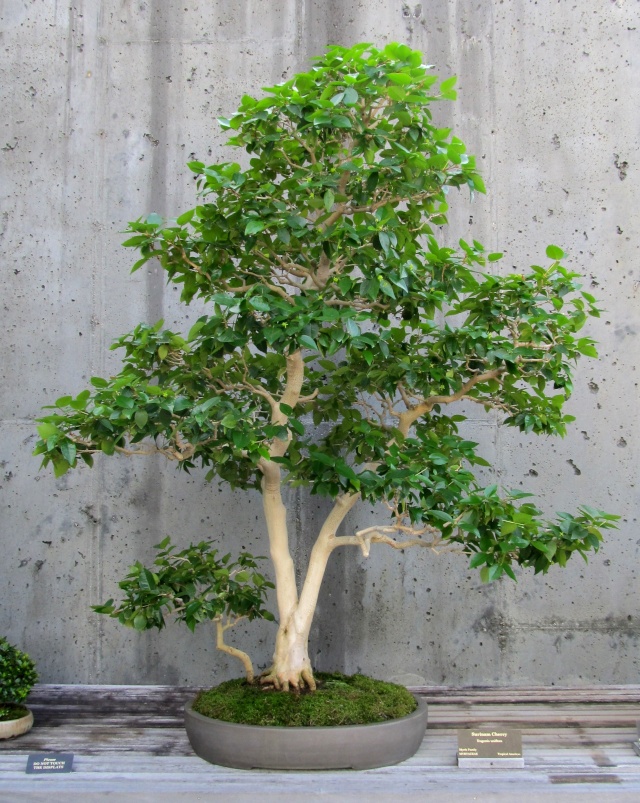
It is a Surinam Cherry (Eugenia uniflora), also known as Pitanga, Brazilian Cherry or Cayenne Cherry. This species is native to the eastern coast of South America, but here in the US it is commonly planted in Florida as a hedge or screen. In Bermuda it has naturalized and is listed as an invasive species. The fruit is bright red and about the size of a cherry, and it is edible, but this is not a true cherry. The specimen in our collection was part of the original donation we received in 1992, and at that time it looked like this:
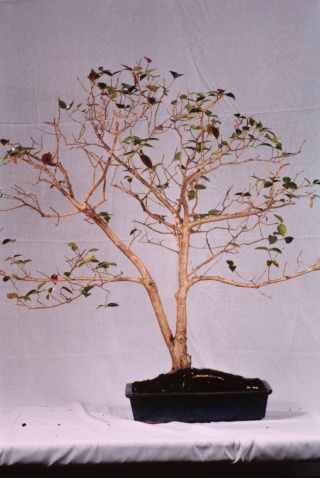
When I went to study with Yuji Yoshimura in January of 1995, I took along photographs of various Arboretum bonsai to show him and seek his advice. At that point I had worked the Surinam Cherry into this shape:
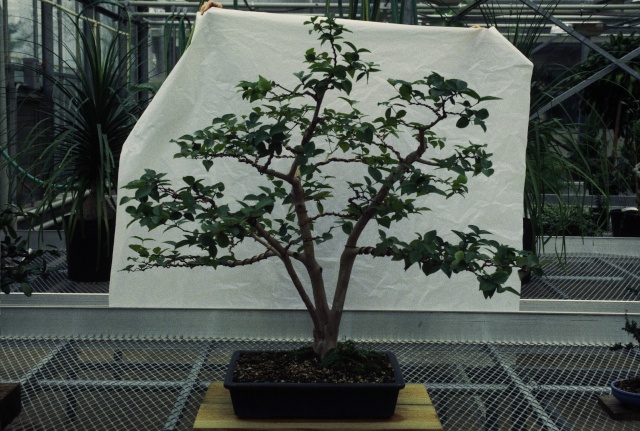
Mr. Yoshimura advised that I remove the smallest trunk altogether, and eliminate one or the other of the 2 lowest branches on the remaining trunks. His objection was to the fact that these branches were at the same height and created too much of a symmetric feeling in the structure of the tree's crown. I did not do these things automatically but spent some time thinking about it, and ultimately made both of the moves he recommended. This is what the tree looked like in 1999:
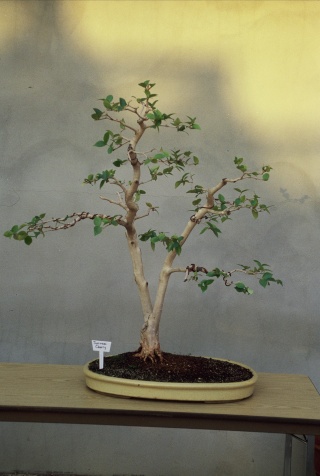
Somewhere in the early 2000's, a small shoot appeared from the ground just to the left of the tree's trunk. Always open to serendipity, I let it remain and develop and it eventually shaped up into a little tree, almost an accent to the existing tree. The shape of this specimen was always a bit awkward, as it was passing itself off as a twin trunk but in fact was a single trunk that forked into 2 trunks about 6 inches above ground level. The only way to "fix" an arrangement like this is with a saw and I never wanted to do that with this tree. When the third trunk appeared it seemed to me to create some kind of counterbalance in the design, and, accepting the unorthodoxy of it, I found it agreeable. Here is what the tree looked like out on display for the first time in the bonsai garden in 2008:

I do not think this particular specimen has ever found its true pot. I have always resorted to using whatever container I have that is large enough and kind of works. It was in the cream colored oval container for a number of years before I transplanted it into the current gray oval about a month ago, preferring that for its greater depth. The gray color is unobtrusive but also uninteresting. I think a container of the same depth but wider would also be better, but this one will have to do for now. Those large pots are not easy to find and cost a lot of money!
So, how tall is this Surinam Cherry? This picture will give you an idea:
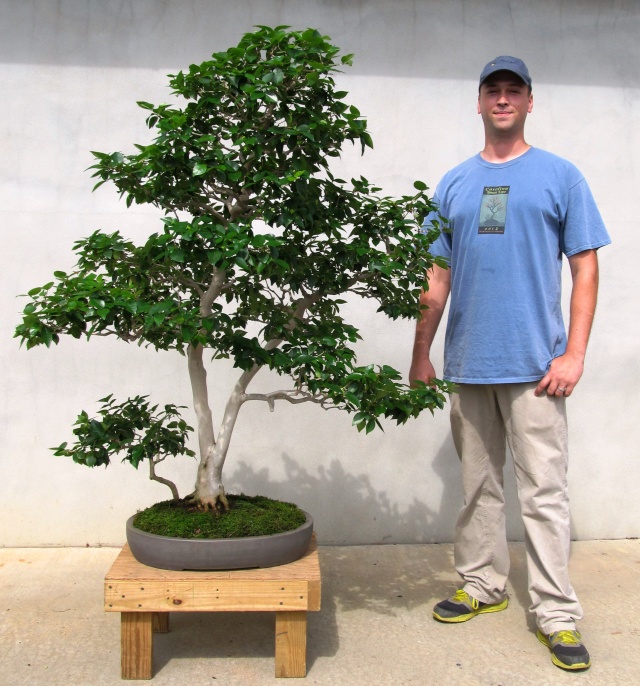
That is my assistant, Joshua, standing next to the tree. He is over 6-foot tall.
Turning away from the subject of pest management, I will take this opportunity to post some pictures of a bonsai that just today was put out on display in the Bonsai Exhibition Garden. This is the tallest tree in the NC Arboretum collection:

It is a Surinam Cherry (Eugenia uniflora), also known as Pitanga, Brazilian Cherry or Cayenne Cherry. This species is native to the eastern coast of South America, but here in the US it is commonly planted in Florida as a hedge or screen. In Bermuda it has naturalized and is listed as an invasive species. The fruit is bright red and about the size of a cherry, and it is edible, but this is not a true cherry. The specimen in our collection was part of the original donation we received in 1992, and at that time it looked like this:

When I went to study with Yuji Yoshimura in January of 1995, I took along photographs of various Arboretum bonsai to show him and seek his advice. At that point I had worked the Surinam Cherry into this shape:

Mr. Yoshimura advised that I remove the smallest trunk altogether, and eliminate one or the other of the 2 lowest branches on the remaining trunks. His objection was to the fact that these branches were at the same height and created too much of a symmetric feeling in the structure of the tree's crown. I did not do these things automatically but spent some time thinking about it, and ultimately made both of the moves he recommended. This is what the tree looked like in 1999:

Somewhere in the early 2000's, a small shoot appeared from the ground just to the left of the tree's trunk. Always open to serendipity, I let it remain and develop and it eventually shaped up into a little tree, almost an accent to the existing tree. The shape of this specimen was always a bit awkward, as it was passing itself off as a twin trunk but in fact was a single trunk that forked into 2 trunks about 6 inches above ground level. The only way to "fix" an arrangement like this is with a saw and I never wanted to do that with this tree. When the third trunk appeared it seemed to me to create some kind of counterbalance in the design, and, accepting the unorthodoxy of it, I found it agreeable. Here is what the tree looked like out on display for the first time in the bonsai garden in 2008:

I do not think this particular specimen has ever found its true pot. I have always resorted to using whatever container I have that is large enough and kind of works. It was in the cream colored oval container for a number of years before I transplanted it into the current gray oval about a month ago, preferring that for its greater depth. The gray color is unobtrusive but also uninteresting. I think a container of the same depth but wider would also be better, but this one will have to do for now. Those large pots are not easy to find and cost a lot of money!
So, how tall is this Surinam Cherry? This picture will give you an idea:

That is my assistant, Joshua, standing next to the tree. He is over 6-foot tall.

Arthur Joura- Member
 Re: American Bonsai at the NC Arboretum
Re: American Bonsai at the NC Arboretum
As a plant pathologist, what Arhur is talking about is called the "integrated pest management system". It is the control of insect pests and diseases in a more sustainable way for man and the environment. Thank you so much for sharing your knowledge and experiences Arthur! Please keep posting.Arthur Joura wrote:
One of the greatest dangers inherent in the use of chemical pesticides is that they are relatively cheap and easily available to anyone, regardless of the competence, intelligence or sanity of the buyer. These are highly lethal substances that can be purchased by anyone at the nearest big box hardware store. The safety of these chemicals depends on the applicator using them the correct way, and especially at the correct rate. Overuse of pesticides is commonplace and one of the pitfalls of this is that the targeted pests can and do over time build up resistance to the chemicals. Then it takes more and more pesticide to achieve ever decreasing results. Meanwhile, presence of the chemicals builds in the environment and begins to affect non-target life forms, sometimes including humans.

sayotefries
sayotefries- Member
Page 3 of 40 •  1, 2, 3, 4 ... 21 ... 40
1, 2, 3, 4 ... 21 ... 40 
 Similar topics
Similar topics» American Bonsai at the NC Arboretum
» WISTERIA BONSAI AT INTERNATIONAL BONSAI ARBORETUM
» Ashville arboretum bonsai
» Trip to the Rochester Arboretum
» Carolina Bonsai Expo @ NC Arboretum
» WISTERIA BONSAI AT INTERNATIONAL BONSAI ARBORETUM
» Ashville arboretum bonsai
» Trip to the Rochester Arboretum
» Carolina Bonsai Expo @ NC Arboretum
Page 3 of 40
Permissions in this forum:
You cannot reply to topics in this forum|
|
|







